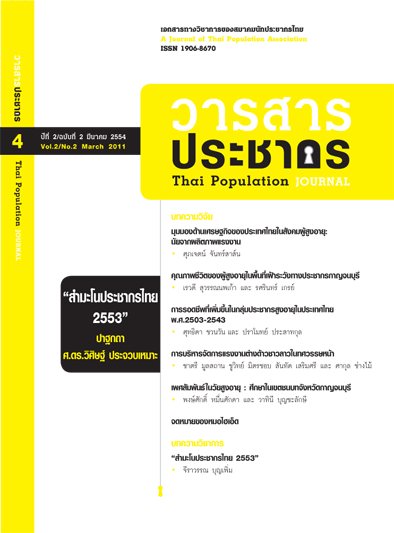ปีที่ 2 ฉบับที่ 2 เดือนมีนาคม 2554
 |
บทความวิจัย
บทความวิชาการ
|
มุมมองด้านเศรษฐกิจของประเทศไทยในสังคมผู้สูงอายุ: นัยจากผลิตภาพแรงงาน
มุมมองด้านเศรษฐกิจของประเทศไทยในสังคมผู้สูงอายุ: นัยจากผลิตภาพแรงงาน
ศุภเจตน์ จันทร์สาส์น
บทคัดย่อ
งานวิจัยเรื่องนี้ทำการวิเคราะห์อัตราการเจริญเติบโตของผลิตภาพแรงงานของประเทศไทยซึ่งจำแนกเป็นภาคการผลิตย่อยรวม 16 ภาค ในช่วงปี พ.ศ.2543-2552 เพื่อวิเคราะห์โอกาสทางเศรษฐกิจของประเทศไทยภายใต้การลดลงของสัดส่วนประชากรวัยแรงงาน จากการศึกษาพบว่า ประเทศไทยมีอัตราการเจริญเติบโตของผลิตภาพแรงงานโดยเฉลี่ยเท่ากับร้อยละ 1.36 ต่อปี ทำให้สามารถสรุปได้ว่าประเทศไทยยังมีโอกาส
ทางเศรษฐกิจที่ดี เนื่องจากประเทศไทยต้องการการเจริญเติบโตของผลิตภาพแรงงานเกินกว่าร้อยละ 0.43 ต่อปี ในช่วงปี พ.ศ.2553-2558 เกินกว่าร้อยละ 0.62 ต่อปี ในช่วงปี พ.ศ.2558-2568 และเกินกว่าร้อยละ 0.53 ต่อปี ในช่วงปี พ.ศ.2568-2573 จึงจะสามารถรักษาการเจริญเติบโตของผลิตภัณฑ์มวลรวมภายในประเทศที่แท้จริงต่อบุคคลได้นั่นเอง อย่างไรก็ตาม ปัญหาจากการที่มีภาคการผลิตย่อย 9 ภาค ที่มีอัตราการเจริญเติบโตของผลิตภาพแรงงานใกล้เคียงหรือต่ำกว่าอัตราการเจริญเติบโตของผลิตภาพแรงงานขั้นต่ำ และปัญหาความผันผวนของอัตราการเจริญเติบโตของผลิตภาพแรงงานในทุกภาคการผลิตย่อยที่อยู่ในระดับสูง อาจส่งผลกระทบต่อโอกาสทางเศรษฐกิจของประเทศไทยในระยะยาว ซึ่งภาครัฐต้องเร่งทำการแก้ไขต่อไป
Thailand’s Economic Prospect in Ageing Society: Implications from Labor Productivity
Supachet Chansarn
ABSTRACT
This study analyzed the growth rate of labor productivity of Thailand which was categorized into 16 sub-sectors during 2000-2009 in order to analyze Thailand’s economic prospect under the diminishing proportion of the population in the working-age group. The findings revealed that Thailand’s average growth rate of labor productivity was 1.36 percent per annum, implying a good economic prospect of Thailand. It is because Thailand needs more than 0.43 percent increase in the growth rate of labor productivity during 2010-2015, more than 0.62 percent during 2015-2025 and more than 0.53 percent during 2025-2030 to offset the decreasing proportion of the population in the working-age group so that Thailand can have the constant growth of real GDP per capita. However, we found that the average growth rates of labor productivity of nine sub-sectors were just close to or lower than the minimum growth rate of labor productivity and the growth rates of labor productivity in every sub-sector were very volatile. These problems may cause an adverse impact on Thailand’s economic prospect in long-run, thus the government must deal with them right away.
คุณภาพชีวิตของผู้สูงอายุในพื้นที่เฝ้าระวังทางประชากรกาญจนบุรี
คุณภาพชีวิตของผู้สูงอายุในพื้นที่เฝ้าระวังทางประชากรกาญจนบุรี
เรวดี สุวรรณนพเก้า และ รศรินทร์ เกรย์
บทคัดย่อ
การศึกษาครั้งนี้มีวัตถุประสงค์ คือ 1) เพื่อศึกษาถึง ระดับคุณภาพชีวิตของผู้สูงอายุในจังหวัดกาญจนบุรีแบบองค์รวม และจำแนกตามองค์ประกอบ (ด้านครอบครัวด้านสุขภาพ ด้านความมั่นคงทางเศรษฐกิจ และด้านมาตรฐานการอยู่อาศัยแลสภาพแวดล้อม) 2) เพื่อศึกษาถึงความสัมพันธ์ระหว่างลักษณะทางประชากร เศรษฐกิจ และสังคม กับคุณภาพชีวิตของผู้สูงอายุในจังหวัดกาญจนบุรีแบบองค์รวม และจำแนกตามองค์ประกอบดังกล่าว การศึกษาครั้งนี้เป็นการศึกษาเชิงวัตถุวิสัย ด้วยข้อมูลทุติยภูมิจากโครงการเฝ้าระวังทางประชากรกาญจนบุรี รอบ 3 (พ.ศ.2545) สำหรับเกณฑ์การแบ่งกลุ่มคุณภาพชีวิตเป็นระดับดี ปานกลาง และต่ำ โดยใช้ค่าเฉลี่ยและค่าเบี่ยงเบนมาตรฐาน ผลการศึกษา พบว่า กลุ่มตัวอย่างประชากรอายุ 60 ปีขึ้นไปจำนวน 3,550 คน หญิงมีสัดส่วนสูงกว่าชาย ส่วนใหญ่เป็นผู้สูงอายุตอนต้น (60-69ปี) เป็นผู้มีคู่ จบระดับประถมศึกษา ไม่ได้ทำงาน และอาศัยอยู่ในพี้นที่ที่มีความเป็นชนบท คุณภาพชีวิตด้านมาตรฐานการอยู่อาศัย และสภาพแวดล้อมที่อยู่ในระดับดีสูงที่สุด (ร้อยละ 15.2) รองลงมาคือ คุณภาพชีวิตด้านครอบครัว (ร้อยละ 14.4) ด้านความมั่นคงทางเศรษฐกิจ (ร้อยละ 6.6) และด้านสุขภาพ (ร้อยละ 4.5) ตามลำดับ จากคุณภาพชีวิตทั้ง 4 ด้านนำมาซึ่งคุณภาพชีวิตองค์รวม พบว่า คุณภาพชีวิตองค์รวมอยู่ในระดับดี ร้อยละ 13.2 จากการวิเคราะห์ถดถอยแบบพหุโลจิสติค กับคุณภาพชีวิตในแต่ละด้าน และองค์รวม โดยเปรียบเทียบผู้สูงอายุที่มีคุณภาพชีวิตดีกับต่ำ พบว่า การศึกษา และพื้่นที่อยู่อาศัยมีความสัมพันธ์กับคุณภาพชีวิตในทุกๆ ด้าน กล่าวคือ ผู้สูงอายุยิ่งมีการศึกษาสูงโอกาสมีคุณภาพชีวิตดีก็สูงขึ้นไปด้วย ผู้สูงอายุที่อาศัยอยู่ในพื้นที่ ที่มีความเป็นเมือง/กึ่งเมือง มีโอกาสที่จะมีคุณภาพชีวิตที่ดี สูงกว่าผู้สูงอายุที่มีการศึกษาน้อยและผู้สูงอายุที่อยู่ในพื้นที่ที่มีลักษณะความเป็นชนบท
Quality of Life of Older Persons in Kanchanaburi Demographic Surveillance System
Rewadee Suwannoppakao and Rossarin Gray
ABSTRACT
This study aims to explore the quality of life of older persons in Kanchanaburi Province. It was measured as the composite index and quality of life components (family, health, economic security, and living standard and environment). The other objective is to investigate the relationship between population, economic and social characteristics and the quality of life of older persons. This research utilized secondary data from the Kanchanaburi Demographic Surveillance System, Round 3 (2002). Mean and standard deviation were used to categorize the quality of life into good, moderate and low levels. The analysis reveals that, among 3,550 people aged 60 years and over, females outnumbered males. Most were in early old age (60-69 years), unemployed, married, completed elementary education and lived in rural areas. Considering the good levelof all components of quality of life, living standard and environment was highest (15.2 percent), followed by family (14.4 percent), economic security (6.6 percent) and health (4.5 percent) respectively. Considering quality of life as a whole, the good level constituted 13.2 percent. The multinomial logistic regression analyzed the relationship between each component and quality of life by comparing the good level with the low level. The results show that education and area of residence were significantly related to quality of life in all components. The elderly with higher education and who lived in urban/semi-urban areas had higher chances to have better quality of life than those with lower education and living in rural areas.
การรอดชีพที่เพิ่มขึ้นในกลุ่มประชากรสูงอายุในประเทศไทย พ.ศ.2503-2543
การรอดชีพที่เพิ่มขึ้นในกลุ่มประชากรสูงอายุในประเทศไทย พ.ศ.2503-2543
ศุทธิดา ชวนวัน และ ปราโมทย์ ประสาทกุล
บทคัดย่อ
ในช่วงระยะเวลา 30 ปีที่ผ่านมา การพัฒนาในด้านต่างๆ ไม่ว่าจะเป็นทางด้านการแพทย์ สาธารณสุข ความเป็นเมือง การมีคุณภาพชีวิตที่ดีขึ้น หรืออิทธิพลจากการลดลงของการเกิด และการตาย ทำให้ประชากรไทยกำลังจะกลายเป็นสังคมผู้สูงอายุจากเหตุผลสนับสนุนหลายอย่างที่ทำให้มนุษย์สามารถมีอายุยืนยาวขึ้นได้ จึงทำให้การศึกษานี้ต้องการที่จะพิสูจน์ว่า การรอดชีพของผู้สูงอายุในอดีตเมื่อครึ่งศตวรรษที่ผ่านมาจะเป็นอย่างไร เมื่อเปรียบเทียบกับการรอดชีพของผู้สูงอายุในรุ่นปัจจุบัน การศึกษานี้ใช้เทคนิคการวิเคราะห์ประชากรทางอ้อม โดยใช้วิธีอัตราส่วนรอดชีพ สำมะโน (Census survival ratio) เพื่อศึกษาการรอดชีพที่เพิ่มขึ้นของผู้สูงอายุในประเทศไทย พ.ศ.2503-2543 ข้อมูลที่ใช้นำมาจากการสำมะโนประชากรและเคหะ ในปี พ.ศ.2503, 2513, 2523, 2533 และ 2543 ที่จัดเก็บโดยสำนักงานสถิติแห่งชาติ ผลการศึกษาพบว่า ผู้สูงอายุในปี พ.ศ.2533-2543 หรือเรียกได้ว่าเป็นผู้สูงอายุรุ่นหลัง จะมีโอกาสในการรอดชีพสูงกว่าผู้สูงอายุที่อยู่ในกลุ่มอายุเดียวกันเมื่อ 30 ปีที่ผ่านมา โดยเฉพาะอย่างยิ่งผู้สูงอายุตอนปลายหรือผู้ที่มีอายุ 80 ปีขึ้นไป ทั้งเพศชายและหญิง จะมีโอกาสในการรอดชีพสูงกว่าผู้สูงอายในกลุ่มอื่น แสดงว่าประชากรไทยมีอายุยืนยาวขึ้น สำหรับเรื่องแบบแผนของการรอดชีพ การศึกษาพบว่าการเปลี่ยนแปลงอัตรารอดชีพจะผันกลับตามอายุ คือ ยิ่งอายุมากขึ้น อัตรารอดชีพจะยิ่งต่ำลง อัตรารอดชีพของผู้หญิงสูงกว่าของผู้ชายในทุกๆ ช่วงอายุ และทุกปี แต่อัตราเพิ่มขึ้นของการรอดชีพในผู้สูงอายุชายจะสูงกว่าของผู้หญิง เมื่อเปรียบเทียบระหว่างผู้สูงอายุรุ่นก่อนกับรุ่นหลัง
Improved survival among elderly in Thailand, 1960-2000
Sutthida Chuanwan and Pramote Prasartkul
ABSTRACT
Medical technology and public health services have been dramatically developing during the past three decades. In addition, the degree of urbanization and well-being of population have become higher, whereas fertility and mortality have been decreasing through time. These phenomena cause an ageing population. Due to the factors making people live longer, it is essential to investigate how different between the survival ratios of elderly in old and later generation are. Conducted by National Statistical Office of Thailand decennially, censuses since 1960 until 2000 are used in this study. To investigate the survival ratio among the elderly in Thailand, the Census Survival Ratio method as an indirect technique is employed. It is found that elderly in the later generation (1990-2000) have higher survival rates compared to the old generation (1960-1970). Additionally, the survival ratios vary inversely by age that means the younger, the higher ratios of survival. The survival ratios of females are greater than the rates of males in every age group through time, while the increase rate of survival ratio among male are higher than that of females in every age group. Finally, compared to the survival ratios in other elderly age group, the ratio of elderly aged 80 and over, the oldest old, increase greatest. Therefore, this can be concluded that people live longer.
